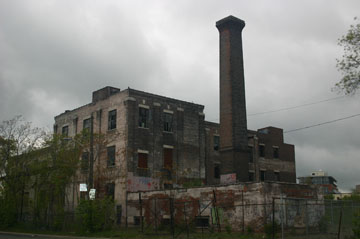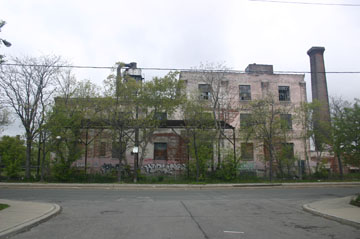 |
|||||||
|
40 Wabash Avenue Toronto Canada
|
|||||||
|
July 17, 08 :
Outline of the proposed Toronto Biennale & Art Residencies at 40 WABASH AVENUE to The Wabash Building Society by the Toronto Biennale Group. ___________TORONTO BIENNALE & ART RESIDENCIES__________ THE WABASH BUILDING BECOMES THE HOME OF THE FIRST YEAR ROUND TORONTO ARTIST RESIDENCIES AND THE TORONTO BIENNALE OUTLINE: The art residencies would operate on an international, national, and local level. They would be self sustaining in that all the residencies would be rented and paid for by an interested country, province, or city. When the biennale is run, every two years, the residency rooms turn into the show rooms for the respective entities that have rented them. The biennales could run summer and winter in alternating fashion every two years. THE BUILDING: Residencies run the gamut but it would be best if the residencies were live/work studios. This keeps both the residencies and the building alive, vibrant, and safe 24/7. How the rooms and building are set up to accomplish the dual task of housing a live/work residency and a biennale are an architectural design issue. An international design competition could be held. The TBG group was attracted to the building because of its derelict condition and were not asking for anything but the bare minimum to bring it up to a level where it would pass all the safety standards. So we would be asking for a restorative design that retained as much of the ' grundge/charactor ' of the building as possible. THE COMMUNITY: The upper floors would hold the residencies and the basement would be for the artist's various workshops but the grounds and much of the ground floor would be mixed use: a sculpture garden, cafeteria, galleries, theaters etc. The galleries and theaters would be for the artists in residence to show their work to the public and for invited local, national, and international curators, lecturers, and art historians to speak on current topics of contemporary art and culture. Gallery space would be rented to institutions like the Textile Museum as extensions to their other locations. Artist run centers would be encouraged to rent space. As history has shown in Toronto, art spaces and events have a positive impact on the community. There is a large push to make the residency/biennale light on car traffic. There would be no encouragement for car usage; i.e. no parking lots and there would be heavy incentives to encourage people to take public transport and bike. It was suggested that a bus route could be rerouted down Wabash Avenue, also a shuttle run from strategic parts of the city to the biennale/residencies. FUNDING: Optimally in time, all the spaces will pay for themselves through rental. The initial funding and the operating costs of both the biennale and the residencies will have to be raised through applications to the various funding bodies, arts councils, corporate sponsorships - international, local, and private: anyway we can. THE TORONTO BIENNALE (A descriptive text of the biennale, not a formal one yet): Widely acknowledged as the centre of Canadian art practice, Toronto is planning its first contemporary art biennale in 2010. The Toronto Biennale responds to the ever increasing impact of Toronto and its potential to provide a specific context for the presentation of contemporary art. Characterized by its intuitive insight into the art scene of the highly urbanized corridor region of central Canada and the northern U.S.A., the biennale is planned to take place from September to December 2010. With contributions from international artists and Canadian provinces, the biennale will incorporate exhibitions from art entities in Toronto. It represents a first step in a larger profile of Toronto on the international art scene. This biennale is built upon an innovative concept, which includes the rehabilitation of a city-owned industrial site and the inauguration of an international/national artists’ residency project. It is the result of the collaboration of the Wabash Society and the Biennale group under the conceptual umbrella devised by Antonia Lancaster. This undertaking aims to cross traditional boundaries between biennales, exhibitions, institutions, curators and artists and aims to radically move away from the process in which artworks are produced, presented, disseminated and contextualized. This biennale will strive to present contemporary art in an exhibition developed and curated by working artists rather than formalized institutions. Thematically, the exhibition is linked to complex ideas emerging from different modern complexities in a global context and their implications on individuals and societies from around the world and across the country. The project starts from the active involvement of artists in this new global modern reality. The relationship between participating groups will be demonstrated and structured according to an aesthetic thematically built to one another resulting in a productive exchange between the various contemporary art positions, artworks and audiences. The biennale will incorporate a variable geography into its sequence of space in the newly recuperated venue. Local and transnational activities can be perceived as a chain of travelling cultural worlds and idioms, a network of incommensurable experiments in a global culture. Utilizing the notion of a space of encounters, the biennale wants to lay down a porous line between context and practice, form and medium, artist and system, institution and locality. It will include the participation of the Canadian provinces and cities and international entities to become a truly pan-Canadian/international event that in collaboration with other rejuvenated institutions will tie the programme of the Toronto Biennale to the city of Toronto itself. Rupen (TBG - Artist) - Some thoughts: Particular consideration to the building being used as a project that could only happen in a particular building. Sight line views of unaltered parts of the building chosen for particular architectural or previous use reasons to bring out the history, the ghost and essence of the building. A custom fit of building and project with a lower cost. Strict mandate of untapped, bold, forward thinking ideas and practices, omen-like in their energy. Ideas outside critically recognized contemporary art approach. Idea above polish or talent, message over medium. A project that is open to the public not by business hours but daylight, sunrise to sunset hours posted in print. First and last day in which the doors are open 24 hours. Find a way to award people who attend the biennale using any mode of transportation other than private car. This could include a one question survey : how did you get here and this idea could also be tied into one of the projects by an artist and/or room in the biennale. The first project should be heavily advertised as free to all, if not all the time then one day out of the week, Monday or Tuesday? Carl (TBG - Gallerist/Curator) - Some thoughts: The goal of the Toronto Biennale Group is to encourage those artists and thinkers whose work illuminate the contemporary human condition and question traditional values. The work that the Toronto Biennale Group will be most interested in will be of exceptional quality and of unusual nature so as to attract the most innovative artists The TBG is interested in supporting mediums of art from all disciplines such as multi dimensional, film, music etc. The T.B.G. should be open in seeking partnerships with not for profit organizations. Larry ( TBG - Graphic Designer/Musician ) - Some thoughts: Every two years the residences end for three months to allow the Biennale to take place. Given that the building is very sound structurally, and that the roof is presumably shot, when work on the building proceeds, a fourth floor could be added, skillfully designed to fit with the rest of the building. Wabash would be the permanent home and offices of the Biennale although other locations and buildings are also used at the time of the event. Building would house a permanent gallery open to the public. This galley would feature work done through the residency program. It could also host events between Biennales to further promote the Biennale. The outside space around the building should be part of the "complex", as a sculpture garden/ outside meeting area/ outside work areas. Biennale/Residency building should connect by tunnel under Wabash to the residence building if the building across the street is bought as part of the over all project. __________TORONTO BIENNALE & ART RESIDENCIES____________ |
|||||||
 |
|||||||
|
40 Wabash Avenue Toronto Canada
|
|||||||